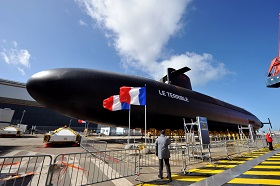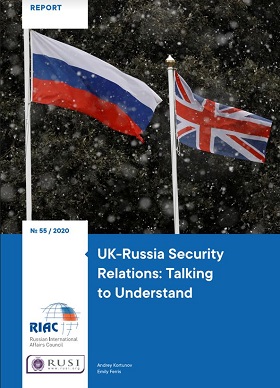Of all the “official” nuclear powers (Russia, the US, France, the UK, China), the UK arguably displays the most peculiar approach to nuclear deterrence. Here, we will outline the most salient details, assess the prospects, and suggest possible confidence-building measures.
As of today, the UK’s nuclear deterrence appears highly optimized, resting on the following three pillars:
- Four UK-manufactured Vanguard-class nuclear-powered ballistic missile submarines (SSBNs) providing “Continuous At-Sea Deterrence,” that is, permanent at-sea presence of at least one ballistic missile submarine (presumably in the North-East Atlantic) ready to deliver a nuclear strike at any time (while another submarine is being readied for patrol at the base and two more are undergoing maintenance)
- Trident-II submarine-launched ballistic missiles (SLBMs) “leased” from the US (unused Tridents are stockpiled at the US naval base appropriately named Kings Bay)
- UK-designed nuclear warheads (presumably with certain specific features making them very similar to US-made W76-family warheads) with a payload of about 100 kt (other variants are also possible) most likely “packaged” in reentry bodies similar to the US-made Mk4/Mk4A.
The UK’s nuclear doctrine guarantees unacceptable damage to any aggressor and there is no doubt that the UK has the requisite capabilities. Nuclear weapons can be used independently or as part of NATO’s nuclear forces. Since 1994, it has been assumed that Tridents are de-targeted. Yet, retention of a certain ambiguity regarding, for instance, the first nuclear strike is considered rather useful in order to bolster deterrence.
Russian scholars note that continuously discounting the UK, with its added US-made SLBMs, from Russia-US nuclear arms control treaties is a way of executing Trident launches that do not count towards the treaties’ telemetry exchange limits. The problem may not be particularly relevant with respect to this venerable missile itself. When, however, a new generation of “Anglo-Saxon” SLBMs appears (approximately by the late 2030s), it might already be too late to discuss new approaches. It is, therefore, unacceptable to reduce the problem of multilateral nuclear control to the Russia-US-China triangle.
When it comes to the UK, traditionally proposed transparency measures appear too timid, given the “material” aspect of the UK’s nuclear deterrence architecture, as described above. Still, searching for uniform approaches to the declarative information on deployed and non-deployed nuclear forces, to notifications of test launches, etc. could promote further advances toward multilateral arms control.
The topic of the Russia-UK “para-nuclear” interaction conducted both bilaterally and within the “P5” (which was originally London’s idea) has been researched very thoroughly, and proposed cooperation options deserve the closest attention.
In conclusion, let us note that the British authorities are experts at providing information to the public at large. Certainly, the publicly accessible data are not exhaustive, but any attempt to clarify Russian nuclear deterrence approaches (which are significantly more multi-level and involve qualitatively different elements) in a similar manner would be a useful exercise at the very least.
Of all the “official” nuclear powers (Russia, the US, France, the UK, China), the UK arguably displays the most peculiar approach to nuclear deterrence. Here, we will outline the most salient details, assess the prospects, and suggest possible confidence-building measures.
The Hardware
Let us start with the “hardware” before addressing various conceptual features. As of today, the UK’s nuclear deterrence appears highly optimized, resting on the following three pillars:
- Four UK-manufactured Vanguard-class nuclear-powered ballistic missile submarines (SSBNs) providing “Continuous At-Sea Deterrence,” that is, permanent at-sea presence of at least one ballistic missile submarine (presumably in the North-East Atlantic) ready to deliver a nuclear strike at any time (while another submarine is being readied for patrol at the base and two more are undergoing maintenance)
- Trident-II submarine-launched ballistic missiles (SLBMs) “leased” from the US (unused Tridents are stockpiled at the US naval base appropriately named Kings Bay)
- UK-designed nuclear warheads (presumably with certain specific features making them very similar to US-made W76-family warheads) with a payload of about 100 kt (other variants are also possible) most likely “packaged” in reentry bodies similar to the US-made Mk4/Mk4A.
The total number of warheads is steadily declining, with the goal of reducing the amount from 200 currently to only 180 by the mid-2020s. The latest 2015 stage legally enshrined the following figures: not more than operationally available 120 warheads with a maximum of 40 warheads per SSBN on combat patrol.
As regards nuclear payloads for British SSBNs, it is a curious (though not officially confirmed) fact that, while the US creating the low-yield W76-2 warheads prompted rather passionate debates worldwide, the Royal Navy has never caused anyone any particular concern even though it has roughly the same weapons.
Currently, work is underway to develop a new generation of aptly-named Dreadnought-class strategic missile submarines that will replace the Vanguard-class SSBNs in early 2030s and ensure that the UK has a “convincing, independent, and battle-worthy” deterrent until 2060. The new Dreadnoughts will be equipped with 12-SLBM “common missile compartments” (CMC) (three four-tube launchers), while actually carrying eight SLBMs, which is similar to the new Columbia-class American SSBN developed with a significant financial contribution from London. Incidentally, American partners are working with their British allies on developing the nuclear power unit for the Dreadnoughts.
Work has already started on the lead Dreadnought SSBN (2016), on the first follow-up Valiant (2019); the second and third follow-ups will be called, no less aptly, Warspite and King George VI.
An interesting development in recent months is that American officials have announced a programme for developing new W93/Mk7 SLBM warheads (in terms of START treaties, we may say that W refers to warheads, while Mk refers to reentry bodies) and directly mentioned cooperation with the UK. This came as news to the British expert community, especially since the UK’s Ministry of Defence is mandated to notify the Parliament about any plans to develop new nuclear weapons. Giving credit where it is due, a relevant public statement was made very promptly.
Certainly, debates around the term “new” when it comes to nuclear warheads (especially since one would like to believe there are no opportunities or plans for nuclear test explosions) are extremely interesting in and of themselves, and each party may gain nothing. Yet, this situation serves as a vivid illustration of possible “glitches” in coordinating “para-nuclear” communications, even between the closest allies. Currently, though, there are more questions than answers related to W93.
The UK’s SSBNs are based at the Clyde naval base in Scotland. Certainly, despite Brexit, the prospects for an independent (and non-nuclear) Scotland remain rather slim, yet, if London’s worst-case scenario comes true, a new site will have to be found and new infrastructure built in a very short order.
The Concept
The UK’s nuclear doctrine guarantees unacceptable damage to any aggressor and there is no doubt that the UK has the requisite capabilities. Nuclear weapons can be used independently or as part of NATO’s nuclear forces. Since 1994, it has been assumed that Tridents are de-targeted. Yet, retention of a certain ambiguity regarding, for instance, the first nuclear strike is considered rather useful in order to bolster deterrence.
The order to use nuclear weapons can only be given by the Prime Minister, although experts believe the decision would be collegial. The order would travel from a special room in a bunker beneath Whitehall, down the chain of command to a SSBN and, at each stage, two people would participate in “passing the signal.” The order could, it is believed, be issued from the Prime Minister’s airplane, as well, but it would still travel via the Pindar.
Current Prime Minister Boris Johnson’s coming down with coronavirus once again brought to the fore the issue of delegating responsibility for the “nuclear button.” The Prime Minister may supposedly personally appoint up to three “nuclear deputies” in the government, whose identity is kept secret and who are vested with the authority to commit nuclear forces in a predetermined order. During the Cold War, “nuclear deputies” (two, as a rule) were selected from among the Foreign Secretary, the Defence Secretary, and the Home Secretary. The procedure was suspended after the end of the Cold War but resumed in 2001. Supposedly, while Boris Johnson was in the hospital, Foreign Secretary Dominic Raab acted as such a “deputy”, in the same way that he shouldered other duties of the Prime Minister.
A curious feature of the British nuclear forces combat control is the tradition of written letters whereby the Prime Minister describes procedures and lists targets for a nuclear conflict; subsequently, such a “letter” is sealed in an envelope and placed in a safe box onboard each SSBN. When a prime minister leaves office, the letters are destroyed unopened and new letters are delivered (sealed as well). Remarkably, even though the world has been afflicted by a real epidemic of leaked official and sensitive information, the contents of such “envelopes” remain inaccessible to researchers even today. Nonetheless, the possible “options” given to an SSBN’s captain include: “retaliate,” “do not retaliate,” “use your own judgement,” “place the submarine under an allied country's command.”
The People
The Royal Navy is staffed by flesh-and-blood people, the result being sex and drugs scandals and possible danger to maintaining CASD amid the COVID-2019 pandemic. Confined spaces often without access to outside air are, in general, good breeding grounds for infections, so reasonable concerns have been voiced about breaking CASD for the first time in the 50 years it has been in place. It should be stressed, however, that should this happen, even a sick crew would launch a missile if such a need arose, and a second submarine would be ready to go on combat patrol immediately.
It is not certain whether human error led to the failed submarine test launch of a Trident missile in the summer of 2016 (the British crew reportedly did everything by the book but the American-made missile failed), but the “political dimension” of the situation was very personal. According to media reports, Barack Obama personally asked then Prime Minister David Cameron to keep the details of the incident a secret. Theresa May, who became Prime Minister shortly afterwards, also kept mum. One of the first “victories” of the new cabinet was a successful vote on renewing the British deterrence programme (this ultimately became the above-mentioned Dreadnought). It is hard to say whether things would have gone differently if the information had been made public in a timely manner but, on the whole, the picture is not entirely seemly (even if not entirely new).
The UK’s powerful anti-nuclear movement is another important “human” factor and sometimes a source of remarkable documents. The starkest example is probably a report on the consequences of an SSBN nuclear attack on Moscow. We will not go into every detail of this valuable material but do note that, based on the calculations therein, up to half of Moscow’s population would die. Certainly, Moscow’s missile defence can handle some threats but the hypothetical British attack could involve several submarines. Of course, this is a purely hypothetical scenario, yet it serves best to show the destructive power even such a modest (compared to Russia and the US) nuclear potential has.
The International Dimension
Unlike France, with its emphatic “nuclear independence,” the UK has always maintained a significant “international element” in its nuclear development, primarily through close cooperation with the US. In the late 1970s, for instance, the UK had nearly 400 American warheads, including such exotic ones as artillery shells and nuclear landmines. At the same time, when it comes to arms control, the nuclear stockpiles of the US’ allies have traditionally been discounted.
Russian scholars note that continuously discounting the UK, with its added US-made SLBMs, from Russia-US nuclear arms control treaties is a way of executing Trident launches that do not count towards the treaties’ telemetry exchange limits. The problem may not be particularly relevant with respect to this venerable missile itself. When, however, a new generation of “Anglo-Saxon” SLBMs appears (approximately by the late 2030s), it might already be too late to discuss new approaches. It is, therefore, unacceptable to reduce the problem of multilateral nuclear control to the Russia-US-China triangle.
When it comes to the UK, traditionally proposed transparency measures appear too timid, given the “material” aspect of the UK’s nuclear deterrence architecture, as described above. Still, searching for uniform approaches to the declarative information on deployed and non-deployed nuclear forces, to notifications of test launches, etc. could promote further advances toward multilateral arms control.
The topic of the Russia-UK “para-nuclear” interaction conducted both bilaterally and within the “P5” (which was originally London’s idea) has been researched very thoroughly, and proposed cooperation options deserve the closest attention.
In conclusion, let us note that the British authorities are experts at providing information to the public at large. Certainly, the publicly accessible data are not exhaustive, but any attempt to clarify Russian nuclear deterrence approaches (which are significantly more multi-level and involve qualitatively different elements) in a similar manner would be a useful exercise at the very least.








